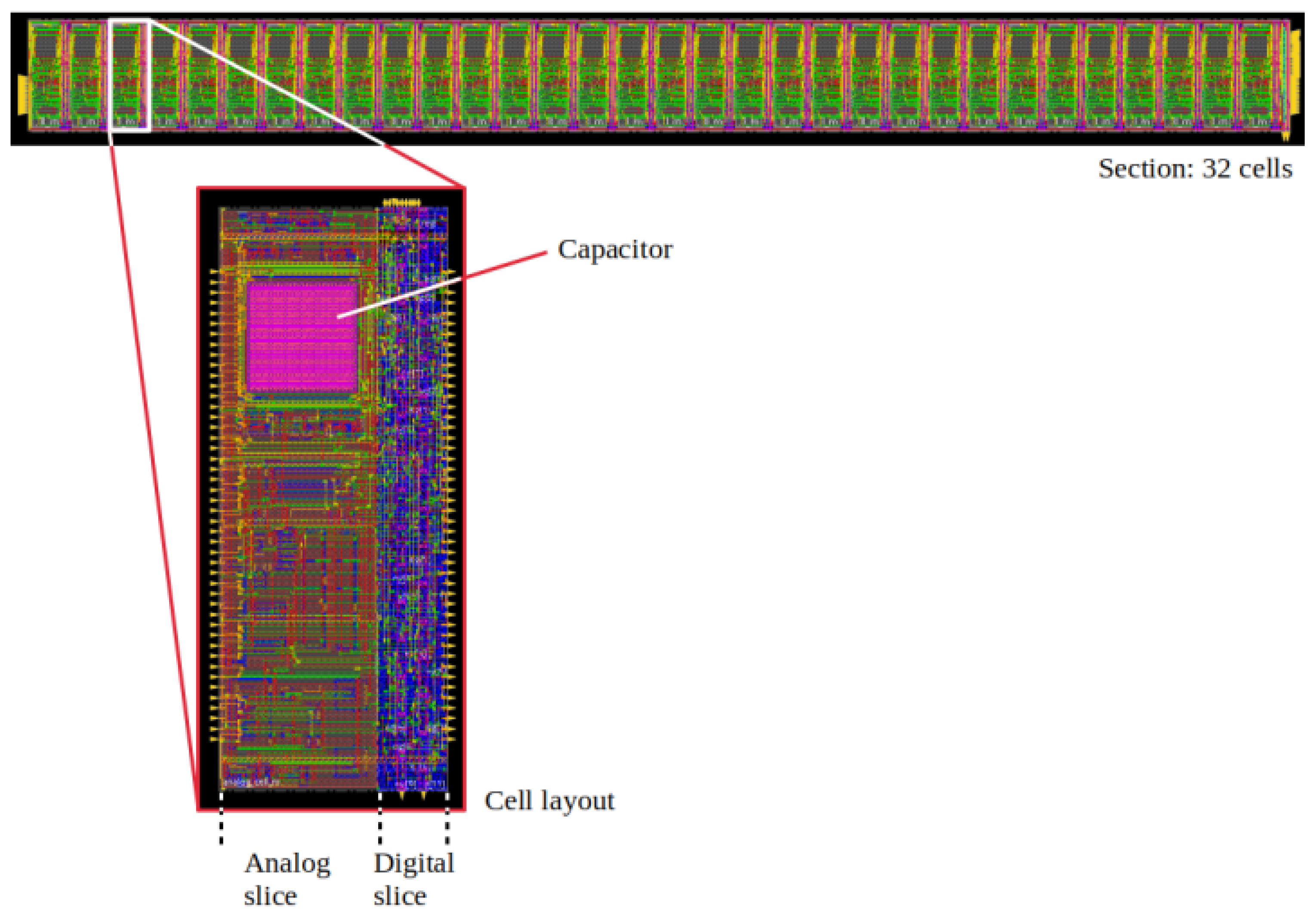A Configurable 64-Channel ASIC for Cherenkov Radiation Detection from Space
Abstract
:1. Introduction
2. Materials and Methods
2.1. Camera Architecture
2.2. ASIC Architecture
Hitmap Generator
- (a)
- The hit is concentrated into a single pixel, candidating a direct cosmic ray or a possible neutrino-event if no bi-focality is implemented in the optical system;
- (b)
- The event is split into two corresponding pixels in the case of a system which adopts the bi-focality to discriminate a signal from a UHECR or UHE neutrino with respect to a direct cosmic ray hit in the detector;
- (c)
- An event occurs at the edge of the SiPM tile, suggesting an adjacent event in the nearby tile;
- (d)
- A light pollution due to a city can flare a large area of the tile.
- TIME WINDOW: a time window is defined using a programmable 6-bits register with a step of 5 ns. At the end of this period, a hitmap is generated, nevertheless a physical event occurred or not;
- HIGH THRESHOLD + COINCIDENCE + EDGE DRIVEN: the high threshold is continuously checked. If it is verified, a read hitmap request is sent to the FPGA, otherwise the coincidence condition is tested within another programmable window. If this case also fails, the pixels at the edges are monitored and a read request is generated as well;
- FPGA REQUEST: the last mode is reserved for the active interaction with the FPGA, which can require the local generation of a hitmap. This feature results in being useful when the user wants an entire snapshot of the entire focal plane.
3. Results
4. Discussion
5. Conclusions
Author Contributions
Funding
Conflicts of Interest
References
- Eser, J.; Olinto, A.V.; Wiencke, L. Overview and First Results of EUSO-SPB2. In Proceedings of the 38th International Cosmic Ray Conference (ICRC2023), Nagoya, Japan, 26 July–3 August 2023; Volume 444. [Google Scholar]
- Burmistrov, L. NUSES Collaboration. Terzina on board NUSES: A pathfinder for EAS Cherenkov Light Detection from space. arXiv 2023, arXiv:2304.11992. [Google Scholar]
- Olinto, A.V.; Krizmanic, J.; Adams, J.H.; Aloisio, R.; Anchordoqui, L.A.; Anzalone, A.; Bagheri, M.; Barghini, D.; Battisti, M.; Bergman, D.R.; et al. The POEMMA (Probe of Extreme Multi-Messenger Astrophysics) observatory. J. Cosmol. Astropart. Phys. 2021, 2021, 007. [Google Scholar] [CrossRef]
- De Mitri, I.; Di Santo, M. The NUSES space mission. J. Phys. Conf. Ser. 2023, 2429, 012007. [Google Scholar] [CrossRef]
- De Mitri, I.; Di Santo, M. The Ziré instrument on board the NUSES space mission. In Proceedings of the 38th International Cosmic Ray Conference (ICRC2023), Nagoya, Japan, 26 July–3 August 2023; Volume 139. [Google Scholar]
- Tedesco, S.; Di Salvo, A.; Rivetti, A.; Bertaina, M. A 64-channel waveform sampling ASIC for SiPM in space-born applications. J. Instrum. 2023, 18, C02022. [Google Scholar] [CrossRef]




| Block | Power | Area | N | Power | Area |
|---|---|---|---|---|---|
| (W) | (m) | (W) | (m) | ||
| Cell | 352 | 256 | |||
| Section | 96 | 8 | 772 | ||
| Section controller | 840 | 4 | 3360 | ||
| Gray counter | 376 | 1 | 376 | ||
| Gray decoder | 357 | 1 | 357 | ||
| Channel controller | 8083 | 1 | 8083 | ||
| Total |
Disclaimer/Publisher’s Note: The statements, opinions and data contained in all publications are solely those of the individual author(s) and contributor(s) and not of MDPI and/or the editor(s). MDPI and/or the editor(s) disclaim responsibility for any injury to people or property resulting from any ideas, methods, instructions or products referred to in the content. |
© 2023 by the authors. Licensee MDPI, Basel, Switzerland. This article is an open access article distributed under the terms and conditions of the Creative Commons Attribution (CC BY) license (https://creativecommons.org/licenses/by/4.0/).
Share and Cite
Di Salvo, A.; Garbolino, S.; Mignone, M.; Zugravel, S.C.; Rivetti, A.; Bertaina, M.E.; Palmieri, P.A. A Configurable 64-Channel ASIC for Cherenkov Radiation Detection from Space. Instruments 2023, 7, 50. https://doi.org/10.3390/instruments7040050
Di Salvo A, Garbolino S, Mignone M, Zugravel SC, Rivetti A, Bertaina ME, Palmieri PA. A Configurable 64-Channel ASIC for Cherenkov Radiation Detection from Space. Instruments. 2023; 7(4):50. https://doi.org/10.3390/instruments7040050
Chicago/Turabian StyleDi Salvo, Andrea, Sara Garbolino, Marco Mignone, Stefan Cristi Zugravel, Angelo Rivetti, Mario Edoardo Bertaina, and Pietro Antonio Palmieri. 2023. "A Configurable 64-Channel ASIC for Cherenkov Radiation Detection from Space" Instruments 7, no. 4: 50. https://doi.org/10.3390/instruments7040050







